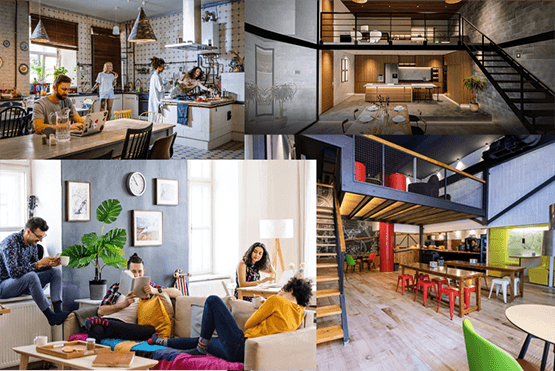In an era characterized by soaring housing costs, burgeoning urban populations, and evolving societal norms, the quest for affordable housing solutions has never been more pressing. As traditional housing models strain under the weight of these challenges, alternative approaches are gaining prominence. Two such innovative housing paradigms, co-housing and co-living, are emerging as potential answers to the affordability crisis, redefining how we think about communal living.
The Rise of Innovative Housing Models
Co-Housing: Fostering Close-Knit Communities
Imagine a living arrangement where you maintain your private space but share communal areas like kitchens, gardens, and common spaces with your neighbors. This is the essence of co-housing – a return to close-knit communities reminiscent of bygone eras.
Affordability:
One of the primary benefits of co-housing is cost-sharing. Expenses for communal facilities are divided among residents, significantly reducing overall living costs.
Community Bonds:
In co-housing communities, strong relationships often flourish as residents collaborate on shared responsibilities, including childcare, maintenance, and even meal preparation. This communal ethos fosters a sense of belonging and mutual support.
Sustainability:
Co-housing promotes sustainable living practices. Shared resources lead to reduced waste and a smaller environmental footprint, aligning with the growing global emphasis on ecological responsibility.
Co-Living: Thriving in Urban Environments
In urban environments, where the cost of renting an entire apartment can be prohibitively high, co-living emerges as a modern solution. Co-living spaces typically offer private furnished bedrooms while sharing common areas like kitchens, lounges, and coworking spaces.
Affordability:
Co-living is especially appealing to young professionals and city dwellers, providing an affordable alternative to renting entire apartments in high-cost urban areas.
Flexibility:
Co-living arrangements often come with shorter leases and built-in communities. This flexibility caters to those seeking temporary housing solutions and a dynamic lifestyle.
Convenience:
Shared amenities, cleaning services, and utilities simplify daily life for co-living residents, freeing them from the burdens of traditional household chores.
Embracing the Future of Affordable Housing
The concept of co-housing and co-living represents more than just a housing trend; it signifies a societal shift towards redefining our relationships with neighbors and living spaces. These innovative models offer not only economic advantages but also a renewed sense of community in an increasingly disconnected world.
As we navigate the challenges of housing affordability, it is essential to explore diverse solutions that align with evolving lifestyles and financial realities. Co-housing and co-living present an exciting opportunity to create more sustainable, socially enriched, and affordable housing options for individuals and communities alike.
In an era where housing affordability remains a global concern, embracing these progressive housing models could be the key to unlocking a brighter, more inclusive future for all. As we continue to explore these innovative alternatives, we open doors to a world where affordable and community-centric living is not just a dream but a tangible reality.





